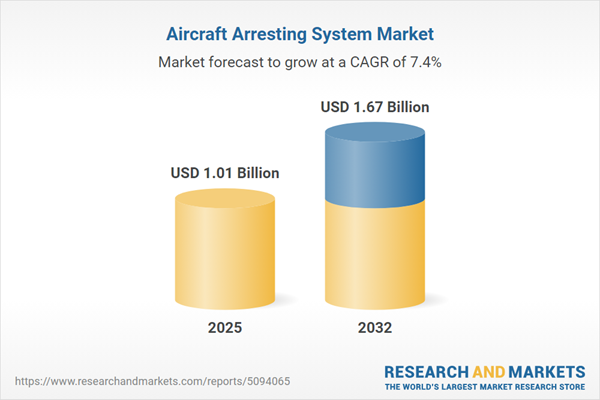Speak directly to the analyst to clarify any post sales queries you may have.
The aircraft arresting system market is undergoing marked transformation, driven by stricter regulatory frameworks, advanced safety requirements, and evolving operational needs. Senior executives seeking dependable, compliant safety systems must now prioritize strategic procurement and modernization, while adapting to dynamic industry standards and emerging technology.
Market Snapshot: Aircraft Arresting System Market Overview
The global aircraft arresting system market currently stands at USD 945.08 million and is expected to reach USD 1.67 billion by 2032, according to recent analysis. A projected CAGR of 7.39% contrasts with historical activity, highlighting steady growth across civil and military aviation segments. Driving this expansion are significant fleet modernizations, widespread infrastructure upgrades, and routine regulatory updates. These factors are fueling rapid evaluation and adoption of innovative arresting technologies worldwide as airfields increase investment to meet higher safety and compliance standards in both established and developing markets.
Scope & Segmentation of the Aircraft Arresting System Market
- System Types: Arresting cable systems, engineered material arresting systems (EMAS), hydro pneumatic solutions, and synthetic net technologies enhance runway safety for civil, defense, and private operators.
- Installation Models: Permanent systems ensure ongoing safety at established locations, while modular and portable models serve temporary, emergency, or shifting operational situations.
- End Users: Airport authorities integrate arresting systems with current safety management platforms; military organizations rely on scalable solutions for distinct mission profiles; private operators select arresting technologies tailored for specific operational settings.
- Aircraft Categories: Arresting solutions are deployed for fixed-wing platforms, helicopters, and unmanned aerial vehicles, improving response capabilities during both scheduled operations and unplanned incidents.
- Regional Coverage: Adoption across the Americas, Europe, Middle East & Africa, and Asia-Pacific varies based on regulatory evolution, infrastructure investments, and regional modernization priorities.
- Major Industry Participants: Leading companies—including Curtis-Wright Corporation, Zodiac Aerospace, Runway Safe, General Atomics, Aries S.A., ATECH Inc., SCAMA AB, Safran SA, and QinetiQ Group—spearhead technical innovation and comprehensive system integration throughout the sector.
Key Takeaways: Strategic Insights for Senior Decision Makers
- Modular and hydro pneumatic options allow phased upgrades, extending asset life and targeting enhancements without major infrastructure changes.
- Advanced digital monitoring delivers improved reliability by supporting early maintenance actions and streamlining disruptions at airfields.
- Use of recyclable and modular materials helps satisfy rising sustainability requirements in aviation infrastructure, aligning investment with environmental objectives.
- Customizable systems support rapid adaptation to new industry standards, operational risks, and regulatory expectations in both civilian and defense contexts.
- Tech differentiation enables bespoke procurement, ensuring solutions match local compliance and operational standards across diverse airfield environments.
Tariff Impact: Supply Chain Strategies and Sourcing Adaptation
Recent United States tariff reforms are prompting greater prioritization of regional and domestic suppliers for critical arresting system components. This shift helps organizations navigate supply chain uncertainty by reducing exposure to disruptions, supporting dependable project timelines, and ensuring adaptation to evolving procurement guidelines.
Methodology & Data Sources
This research combines direct interviews with senior airport executives and manufacturers, and incorporates insights from technical documents, published regulatory analysis, and recent patents. Evaluations use proven market modeling alongside input from subject matter experts, offering senior leaders actionable, validated perspectives.
Why This Report Matters
- Enables executive teams to assess arresting system procurement for safety and regulatory compliance across commercial, defense, and private aviation operations.
- Offers practical guidance for adapting sourcing strategies and overcoming procurement challenges resulting from shifting tariff policies.
- Illuminates developments in regulatory standards and risk management, providing a foundation for ongoing modernization and enhanced airfield safety initiatives.
Conclusion
Continued advancements in aircraft arresting systems are strengthening operational safety and organizational resilience. Senior decision makers can leverage these insights to guide investments and optimize performance in a regulatory landscape marked by ongoing change.
Additional Product Information:
- Purchase of this report includes 1 year online access with quarterly updates.
- This report can be updated on request. Please contact our Customer Experience team using the Ask a Question widget on our website.
Table of Contents
3. Executive Summary
4. Market Overview
7. Cumulative Impact of Artificial Intelligence 2025
Companies Mentioned
The companies profiled in this Aircraft Arresting System market report include:- Curtiss-Wright Corporation
- Zodiac Aerospace
- Runway Safe
- General Atomics
- Aries S.A.
- ATECH Inc.
- GENERAL ATOMICS
- Scandinavian Manufacturing SCAMA AB
- Safran SA
- QinetiQ Group
Table Information
| Report Attribute | Details |
|---|---|
| No. of Pages | 198 |
| Published | November 2025 |
| Forecast Period | 2025 - 2032 |
| Estimated Market Value ( USD | $ 1.01 Billion |
| Forecasted Market Value ( USD | $ 1.67 Billion |
| Compound Annual Growth Rate | 7.3% |
| Regions Covered | Global |
| No. of Companies Mentioned | 11 |









